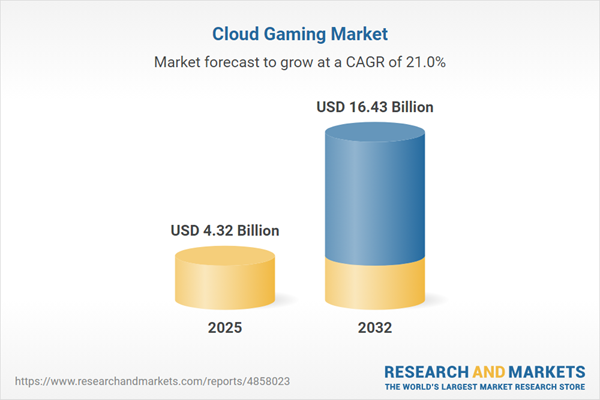Speak directly to the analyst to clarify any post sales queries you may have.
Cloud gaming is transforming the digital entertainment landscape by eliminating hardware dependencies and delivering seamless, on-demand gameplay through cloud infrastructure. Senior leaders exploring scalable platforms and disruptive engagement models will find the current market environment defined by rapid innovation, evolving strategies, and unique operational challenges.
Cloud Gaming Market Snapshot
The cloud gaming market grew from USD 3.57 billion in 2024 to USD 4.32 billion in 2025, and is projected to expand at a CAGR of 21%, reaching USD 16.43 billion by 2032. This growth reflects significant advancements in network architecture, widespread 5G rollouts, and increased adoption of edge computing to deliver high-quality, low-latency gameplay. As publishers and platform providers leverage these technical innovations, the user base diversifies, and recurring engagement rises through subscription and bundled service models. Intensifying regional competition and a varied regulatory landscape add further momentum and complexity to market dynamics.
Scope & Segmentation
- Device Types: Game consoles, PCs, smart TVs, smartphones, and tablets are the primary delivery endpoints for cloud-based gaming, each with distinct performance and interface requirements.
- Game Genres: Action, racing, role-playing, sports, and strategy genres present varying demands on graphical fidelity, input responsiveness, and network infrastructure.
- Monetization Models: Advertising, freemium, subscription, and transactional purchases shape revenue streams, influencing user acquisition and retention strategies.
- End Users: Businesses use cloud gaming for training and cloud-native development, while consumers engage for entertainment, necessitating differentiated solutions and service levels.
- Regional Coverage: Americas (including United States, Canada, Mexico, Brazil, Argentina, Chile, Colombia, Peru), Europe, Middle East & Africa (including United Kingdom, Germany, France, Russia, Italy, Spain, Netherlands, Sweden, Poland, Switzerland, UAE, Saudi Arabia, Qatar, Turkey, Israel, South Africa, Nigeria, Egypt, Kenya), and Asia-Pacific (including China, India, Japan, Australia, South Korea, Indonesia, Thailand, Malaysia, Singapore, Taiwan).
- Companies Profiled: NVIDIA Corporation, Microsoft Corporation, Sony Interactive Entertainment LLC, Google LLC by Alphabet Inc., Amazon.com, Inc., Tencent Holdings Limited, NetEase, Inc., Blacknut SAS, Blade SAS, Boosteroid SRL.
- Technology Trends: Advancements in network architecture, 5G, edge computing, open standards, and interoperability initiatives are shaping streaming quality and deployment agility.
Key Takeaways for Decision-Makers
- Strategic partnerships across telecommunications, infrastructure, and content sectors are critical for optimizing latency reduction, performance, and user reach.
- Diversification of monetization—combining subscriptions, advertising, and in-game commerce—creates resilience to price sensitivity and enables recurring engagement.
- Edge computing and distributed data center investments are vital for ensuring ultra-low-latency experiences and expanding into underserved or high-growth regions.
- Device segmentation influences platform interface design and prioritization of network resources to ensure compatibility and a consistent user experience across endpoints.
- Tailored solutions are necessary for both consumer audiences seeking personalized entertainment and businesses utilizing cloud gaming for innovative, enterprise-driven applications.
- Competitive differentiation increasingly depends on proprietary content rights, open developer ecosystems, and rapid integration of new features enabled by cloud-native architectures.
Tariff Impact and Supply Chain Shifts
Recent United States tariff measures on gaming hardware components and imported technologies have introduced cost pressures on cloud gaming providers, prompting reassessment of deployment strategies and hardware sourcing. Organizations are exploring onshore manufacturing and localized supply chains to manage risk and ensure consistent service delivery. These trade policy shifts also compel closer collaboration between platform developers and regional partners to mitigate potential cost transfers to users.
Market Research Methodology & Data Sources
This study utilizes interviews with industry executives, analysis of data center deployments, and benchmarking of network performance across key markets. Secondary research includes technology white papers, regulatory documents, and expert workshops to validate assumptions. Quantitative insights stem from anonymized usage data, supported by scenario planning to reflect evolving technology, regulatory, and trade environments.
Why This Report Matters
- Supports strategic planning by clarifying how emerging technologies and regional trends impact service delivery and monetization strategies.
- Helps executive teams navigate regulatory and supply chain risks to secure sustainable growth and market leadership.
- Equips product and partnership leads with actionable market segmentation insights to tailor offerings and foster deeper ecosystem engagement.
Conclusion
Cloud gaming’s evolution is shaped by technical innovation, agile partnerships, and strategic responses to regulatory and supply chain pressures. Stakeholders able to adapt rapidly and capitalize on differentiated content and seamless delivery will secure a competitive advantage in the next era of interactive entertainment.
Additional Product Information:
- Purchase of this report includes 1 year online access with quarterly updates.
- This report can be updated on request. Please contact our Customer Experience team using the Ask a Question widget on our website.
Table of Contents
3. Executive Summary
4. Market Overview
7. Cumulative Impact of Artificial Intelligence 2025
Companies Mentioned
The companies profiled in this Cloud Gaming market report include:- NVIDIA Corporation
- Microsoft Corporation
- Sony Interactive Entertainment LLC
- Google LLC by Alphabet Inc.
- Amazon.com, Inc.
- Tencent Holdings Limited
- NetEase, Inc.
- Blacknut SAS
- Blade SAS
- Boosteroid SRL
Table Information
| Report Attribute | Details |
|---|---|
| No. of Pages | 198 |
| Published | October 2025 |
| Forecast Period | 2025 - 2032 |
| Estimated Market Value ( USD | $ 4.32 Billion |
| Forecasted Market Value ( USD | $ 16.43 Billion |
| Compound Annual Growth Rate | 21.0% |
| Regions Covered | Global |
| No. of Companies Mentioned | 11 |









